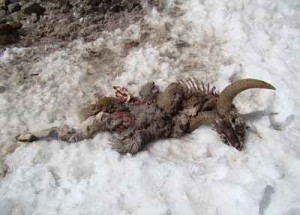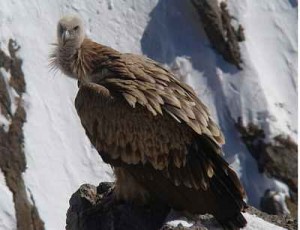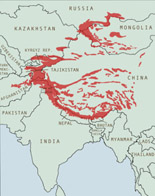
Carcass of a bharal (wild goat) killed by snow leopard. Photo Kulbhushansingh Suryawanshi
A fascinating report of a snow leopard killing a wild goat high up in the Indian Himalayas by Kulbhushansingh Suryawanshi, who is a research scholar with the Nature Conservation Foundation in Mysore, India.
“An hour of hard climbing through knee-deep snow took me to the crest of the plateau at an altitude of 4,500 metres. I gasped for breath in the rarefied air of the endless Tibetan steppe grassland that extended in front of me. Resting my weight on an ice axe, I was admiring the panoramic view when a silhouette on the snow caught my eye. It was a snow leopard moving gently, almost like an elf, hardly leaving a footprint. It was about 200 metres away, perpendicular to my line of sight, and seemed unaware of my presence. I sank to my knees and reached for my binoculars.

Vulture near a bharal (wild goat) killed by snow leopard. Photo Kulbhushansingh Suryawanshi
Very few outsiders have seen it in its natural environment in the high altitudes of the Himalayas. I got this rare opportunity in Spiti Valley in the remote trans-Himalayan region of Himachal Pradesh.
Suddenly, the snow leopard stopped, crouched low, and started staring at something. From my position I could not see what it was looking at. I crawled to the top of a small hump, taking care to avoid being seen by the animal. A group of about 30 bharal (a wild goat) was grazing on a small patch of grass about 300 metres from the snow leopard.
Using the cover of small rocks and bushes, it now started moving closer to the bharal. There was an unnerving silence all around. Just when I expected the snow leopard to move closer to the bharal, the silence was broken by the loud ‘honking’ of a donkey. It came from behind me; the livestock of the village had moved closer and was now about 500 metres behind me. The snow leopard withdrew into the rocks and kept a close eye on both the livestock and the bharal.
The snow leopard retreated further into the rocks and I could not see it any more. I held my position for a long time. Before I realised it, evening was upon us. It got colder and dark. The livestock had also retreated towards the village. The stalemate had been resolved. The livestock had been ignored over the bharal, saving the herder and the snow leopard a lot of trouble.
The next morning I went back to the Rungalong plateau, the site of the pervious day’s encounter with the snow leopard.
A scanning of the landscape drew my attention to a flock of vultures. They led me to the place where the snow leopard had made its kill the previous night – a male bharal, about four years old. The vultures were tearing at whatever remained of the kill. The snow around the kill was sprayed in red, and the pugmarks told the story. There were few signs of a struggle; the marks on the throat indicated a swift kill. There was still some portion of the kill left, and I expected the leopard to return for it in the evening.”
Rungalong is adjacent to the reserved area of Kibber village in northern India. The local people, with support from the Nature Conservation Foundation, a non-governmental organisation based in Mysore, have stopped grazing their livestock to help revive the wild bharal population and turn this area into prime snow leopard habitat. Story from The Hindu.




{ 0 comments… add one }